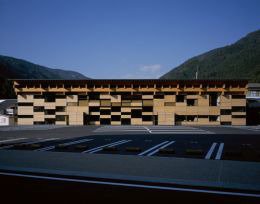Building with Timber
dal 8/11/2011 al 4/2/2012
Segnalato da
8/11/2011
Building with Timber
Architekturmuseum, Munich
Paths into the Future. The exhibition analyzes the ecological importance, the technological potential as well as the new aesthetics of the wood.

The United Nations have proclaimed 2011 the »International Year of Forests«. On this occasion the Architekturmuseum in cooperation with the Department for Timber Construction at the TU München is presenting in an extensive exhibition entitled »Building with Timber – Paths into the Future« the technical, economic and structural possibilities of the material. Wood has acquired an importance as a building material that, only a few years ago, would have been unimaginable. Since the 1970s, a growing global awareness of the need to use resources sparingly and to follow certain ecological principles has introduced a new way of thinking in the building industry, too.
Research into building technology has brought about major improvements in the fire safety and insulation against noise of timber buildings, while computer-aided calculation and production methods make possible entirely new forms of design. Thus today, one of the world’s oldest building materials makes decisive contributions to an architecture that uses resources more sparingly; a familiar material is presented in a new kind of diversity. These are the contents that shape the exhibition Building with Timber – Paths into the Future, which aims to convey this transformation to a broad public in a comprehensible and descriptive way.
The description begins with the forest, which provides the material, but also, above and beyond this, plays an important role in securing the existence of life on our planet. Around one-third of the land area of the earth is covered with forests, which could be described as materialised solar energy.
They develop through the process of photosynthesis, in which carbon dioxide is bound and oxygen released. The forest is therefore a decisive climatic factor and a giver of life, whose products provide work and a livelihood for around 1.6 billion people. In order to maintain this importance, forests have to be cultivated and looked after sustainably. This has been regulated by law in Germany for a long time; significantly, the well-established guiding motto for ecological thinking ‘sustainability’ originates from forestry. Through greater use of wood, a ‘second forest’ could be planted in our towns and villages that would make a sizable contribution to binding carbon dioxide and improving the climate.
After a description of the basic principles of timber construction, wood’s ecological and energy potential is demonstrated using scientific examinations as a basis. This is followed by a presentation of the technological potential. Today new production methods allow completely new ways of building in wood, frequently making it superior to other building materials in economic and energy terms.
The final section presents a number of selected international examples that provide an insight into the new diversity of architectural expression and design possibilities. The projects shown have been chosen according to their informative value on the various topics as well as to their architectural qualities. The focal point is the potential of modern timber construction for larger buildings, the domain of single-family buildings has been excluded.
For a long time, the representatives of modern architecture saw wood as a conventional material that, they believed, could not express new, contemporary concepts. The latest developments have made this dismissal of wood in favour of materials with (allegedly) a stronger and more modern technical expressiveness completely obsolete. On the contrary: wood today can be described as the exponent and guarantee of building that looks to the future.
In the accompanying publication nine renowned experts analyze the ecological importance, the technological potential as well as the new aesthetics of the familiar building material. 50 selected international examples demonstrate the new digital production methods and the architectural variety of modern timber constructions from low-energy houses and wide-span supporting structures to high-rise construction.
Exhibition and catalogue were possible only through generous support and assistance. Our deep gratitude is especially due to the Landesinnungsverband des Bayerischen Zimmererhandwerks (Bavarian Guilds Association for Carpentry), pro Holz Bayern, the Bayerische Staatsministerium für Ernährung, Landwirtschaft und Forsten (Bavarian State Ministry for Nutrition, Agriculture and Forestry), the Deutsche Bundesstiftung Umwelt (Federal German Environmental Foundation) and the Förderverein of the Architekturmuseum der TU München.
Accompanying Programme:
Wed. 14 Dec. 2011 | Lecture by Hermann Kaufmann | WOOD WORKS
Ernst von Siemens-Auditorium in the Pinakothek der Moderne | 18.00 | free entrance
Hermann Kaufmann, architect and professor at the Institute for Architectural Design and Building Technology at the TU München, is one of the pioneers of modern timber construction in Europe. His works, awarded with the highest international prizes, range from commercial and agricultural buildings to housing estates, from community centres and schools to hotels, thus concisely reflecting the change from classical timber construction techniques to the possibilities of new timber-derived products. Kaufmann sets standards for the future in terms of environmental and ecological compatibility beyond spatially innovative solutions.
Thur. 26 Jan. 2012 | Symposium during the exhibition
Ernst von Siemens-Auditorium in the Pinakothek der Moderne | 10.00-18.00 | free entrance
Publication:
Bauen mit Holz – Wege in die Zukunft | Building with Timber – Paths into the Future
edited by Hermann Kaufmann and Winfried Nerdinger
224 pages with numerous coloured illustrations, Prestel Publishing
Museum edition (German) | ISBN 978-3-7913-6392-9 | book-trade edition (German) | ISBN 978-3-7913-5180-3 | book-trade edition (English) | ISBN 978-3-7913-5181-0
Press Office of the Pinakothek Museums
Tine Nehler M.A. | Leitung Presseabteilung T +49 (0)89 23805-286| F +49 (0)89 23805-125 E-mail:presse@pinakothek.de
Press preview: 09.11.2011 | 11.00
Opening: 09.11.2011 | 19.00
Architekturmuseum der TU München in der Pinakothek der Moderne
Arcisstraße 21 München
Hours: tue-sun 10am-6pm, thu 10am-8pm
Admission free



